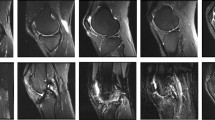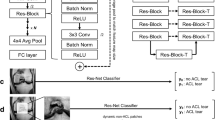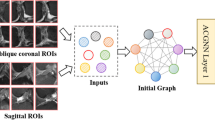Abstract
The anterior cruciate ligament (ACL) is one of the most commonly injured ligaments in the knee. Accurate tear quantification of ACL plays a crucial role in the treatment of patients. This study aims to propose an auxiliary diagnosis scheme based on deep learning (DL) to assist orthopedic surgeons in automatic ACL tear localization and quantification. The proposed scheme adopted a decoupled generative adversarial network (GAN) to generate the distal residual mask and the normal ACL mask, thereby achieving ACL tear classification. Since the edge information of ACL is important in tear classification, we built the decoupled GAN by decoupling the body and edge parts of masks with different supervision and improved its segmentation performance through a histogram equalization for enhancing image quality, an atrous spatial pyramid pooling (ASPP) module and a distribution module for improving feature representations as well as an effective channel attention mechanism. The experiments showed that the decoupled GAN model achieved promising results in the test set and demonstrated its feasibility in ACL segmentation. The proposed scheme also achieved good results in ACL tear quantification (accuracy: 0.929) and yielded a comparable performance with a senior orthopedic surgeon. This work can provide valuable diagnosis evidence of ACL tear for orthopedic surgeons and is expected to apply in clinical practice.








Similar content being viewed by others
Explore related subjects
Discover the latest articles and news from researchers in related subjects, suggested using machine learning.Data availability
The dataset analyzed during the current study are not publicly available due to data privacy but are available from the corresponding author on reasonable request.
References
Duthon V, Barea C, Abrassart S, Fasel J, Fritschy D, Menetrey J (2006) Anatomy of the anterior cruciate ligament. Knee Surg Sports Traumatol Arthroscopy 14(3):204–213
Negahi Shirazi A, Chrzanowski W, Khademhosseini A, Dehghani F (2015) Anterior cruciate ligament: structure, injuries and regenerative treatments. Engineering Mineralized and Load Bearing Tissues 161–186
Musahl V, Karlsson J (2019) Anterior cruciate ligament tear. New England J Med 380(24):2341–2348
Phelan N, Rowland P, Galvin R, OByrne J M (2016) A systematic review and meta-analysis of the diagnostic accuracy of mri for suspected acl and meniscal tears of the knee. Knee Surgery, Sports Traumatology. Arthroscopy 24(5):1525–1539
Meng Y, Zhang H, Zhao Y, Yang X, Qiao Y, MacCormick IJ, Huang X, Zheng Y (2022) Graph-based region and boundary aggregation for biomedical image segmentation. IEEE Transactions on Medical Imaging
Lyu F, Ma AJ, Yip TC-F, Wong GL-H, Yuen PC (2022) Weakly supervised liver tumor segmentation using couinaud segment annotation. IEEE Trans Med Imag
Zhang L, Li M, Zhou Y, Lu G, Zhou Q (2020) Deep learning approach for anterior cruciate ligament lesion detection: evaluation of diagnostic performance using arthroscopy as the reference standard. J Magn Resonance Imag 52(6):1745–1752
Awan MJ, Rahim MSM, Salim N, Rehman A, Nobanee H, Shabir H (2021) Improved deep convolutional neural network to classify osteoarthritis from anterior cruciate ligament tear using magnetic resonance imaging. J Personal Med 11(11):1163
Liu F, Guan B, Zhou Z, Samsonov A, Rosas H, Lian K, Sharma R, Kanarek A, Kim J, Guermazi A et al (2019) Fully automated diagnosis of anterior cruciate ligament tears on knee mr images by using deep learning. Radiol Artifi Intell 1(3):180091
Wahid A, Shah JA, Khan AU, Ullah M, Ayob MZ (2020) Multi-layered basis pursuit algorithms for classification of mr images of knee acl tear. IEEE Access 8:205424–205435
Namiri NK, Flament I, Astuto B, Shah R, Tibrewala R, Caliva F, Link TM, Pedoia V, Majumdar S (2020) Deep learning for hierarchical severity staging of anterior cruciate ligament injuries from mri. Radiol Artifi Intell 2(4):190207
Chang PD, Wong TT, Rasiej MJ (2019) Deep learning for detection of complete anterior cruciate ligament tear. J Digital Imag 32(6):980–986
Flannery SW, Kiapour AM, Edgar DJ, Murray MM, Fleming BC (2021) Automated magnetic resonance image segmentation of the anterior cruciate ligament. J Orthop Res 39(4):831–840
Jeon YS, Yoshino K, Hagiwara S, Watanabe A, Quek ST, Yoshioka H, Feng M (2021) Interpretable and lightweight 3-d deep learning model for automated acl diagnosis. IEEE J Biomed Health Inf 25(7):2388–2397
van der List JP, Mintz DN, DiFelice GS (2017) The location of anterior cruciate ligament tears: a prevalence study using magnetic resonance imaging. Orthop J Sports Med 5(6):2325967117709966
Hanafi MG, Gharibvand MM, Gharibvand RJ, Sadoni H (2018) Diagnostic value of oblique coronal and oblique sagittal magnetic resonance imaging (mri) in diagnosis of anterior cruciate ligament (acl) tears. J Med Life 11(4):281
Chaudhury S, Krishna AN, Gupta S, Sankaran KS, Khan S, Sau K, Raghuvanshi A, Sammy F (2022) Effective image processing and segmentation-based machine learning techniques for diagnosis of breast cancer. Computat Math Methods Med 2022
Du X, Xu X, Liu H, Li S (2021) Tsu-net: Two-stage multi-scale cascade and multi-field fusion u-net for right ventricular segmentation. Comput Med Imag Graph 93:101971
Yu W, Lei B, Ng MK, Cheung AC, Shen Y, Wang S (2021) Tensorizing gan with high-order pooling for alzheimer’s disease assessment. IEEE Trans Neural Netw Learn Syst
Cirillo MD, Abramian D, Eklund A (2020) Vox2vox: 3d-gan for brain tumour segmentation. In: International MICCAI Brainlesion Workshop, pp. 274–284. Springer
Hu S, Lei B, Wang S, Wang Y, Feng Z, Shen Y (2021) Bidirectional mapping generative adversarial networks for brain mr to pet synthesis. IEEE Trans Med Imag 41(1):145–157
You S, Lei B, Wang S, Chui CK, Cheung AC, Liu Y, Gan M, Wu G, Shen Y (2022) Fine perceptive gans for brain mr image super-resolution in wavelet domain. IEEE Trans Neural Netw Learn Syst
Zhu L, He Q, Huang Y, Zhang Z, Zeng J, Lu L, Kong W, Zhou F (2022) Dualmmp-gan: Dual-scale multi-modality perceptual generative adversarial network for medical image segmentation. Comput Biol Med 144:105387
Dong X, Lei Y, Wang T, Thomas M, Tang L, Curran WJ, Liu T, Yang X (2019) Automatic multiorgan segmentation in thorax ct images using u-net-gan. Med Phys 46(5):2157–2168
Han L, Huang Y, Dou H, Wang S, Ahamad S, Luo H, Liu Q, Fan J, Zhang J (2020) Semi-supervised segmentation of lesion from breast ultrasound images with attentional generative adversarial network. Comput Meth Prog Biomed 189:105275
Wang S, Chen Z, You S, Wang B, Shen Y, Lei B (2022) Brain stroke lesion segmentation using consistent perception generative adversarial network. Neural Comput Appl 34(11):8657–8669
Takikawa T, Acuna D, Jampani V, Fidler S (2019) Gated-scnn: Gated shape cnns for semantic segmentation. In: Proceedings of the IEEE/CVF International Conference on Computer Vision, pp. 5229–5238
Zhu Y, Sapra K, Reda FA, Shih KJ, Newsam S, Tao A, Catanzaro B (2019) Improving semantic segmentation via video propagation and label relaxation. In: Proceedings of the IEEE/CVF Conference on Computer Vision and Pattern Recognition, pp. 8856–8865
He H, Li X, Cheng G, Shi J, Tong Y, Meng G, Prinet V, Weng L (2021) Enhanced boundary learning for glass-like object segmentation. In: Proceedings of the IEEE/CVF International Conference on Computer Vision, pp. 15859–15868
Li X, Li X, Zhang L, Cheng G, Shi J, Lin Z, Tan S, Tong Y (2020) Improving semantic segmentation via decoupled body and edge supervision. In: European Conference on Computer Vision, pp. 435–452. Springer
Zhu J-Y, Park T, Isola P, Efros AA (2017) Unpaired image-to-image translation using cycle-consistent adversarial networks. In: Proceedings of the IEEE International Conference on Computer Vision, pp. 2223–2232
He K, Zhang X, Ren S, Sun J (2016) Deep residual learning for image recognition. In: Proceedings of the IEEE Conference on Computer Vision and Pattern Recognition, pp. 770–778
Wang Q, Wu B, Zhu P, Li P, Zuo W, Hu Q (2020) Eca-net: efficient channel attention for deep convolutional neural networks, 2020 ieee. In: CVF Conference on Computer Vision and Pattern Recognition (CVPR). IEEE
Chen L-C, Zhu Y, Papandreou G, Schroff F, Adam H (2018) Encoder-decoder with atrous separable convolution for semantic image segmentation. In: Proceedings of the European Conference on Computer Vision (ECCV), pp. 801–818
Jin Z, Liu B, Chu Q, Yu N (2021) Isnet: Integrate image-level and semantic-level context for semantic segmentation. In: Proceedings of the IEEE/CVF International Conference on Computer Vision, pp. 7189–7198
Liu T, Lu Y, Zhang Y, Hu J, Gao C (2022) A bone segmentation method based on multi-scale features fuse u2net and improved dice loss in ct image process. Biomed Signal Process Control 77:103813
Yeung M, Sala E, Schönlieb C-B, Rundo L (2022) Unified focal loss: Generalising dice and cross entropy-based losses to handle class imbalanced medical image segmentation. Comput Med Imag Graph 95:102026
Huynh C, Tran AT, Luu K, Hoai M (2021) Progressive semantic segmentation. In: Proceedings of the IEEE/CVF Conference on Computer Vision and Pattern Recognition, pp. 16755–16764
Calivà F, Namiri NK, Dubreuil M, Pedoia V, Ozhinsky E, Majumdar S (2022) Studying osteoarthritis with artificial intelligence applied to magnetic resonance imaging. Nature Rev Rheumatol 18(2):112–121
Gustafsson T, Östenberg AH, Alricsson M (2020) Acl diagnosis-the correlation between rolimeter and mri. Sports Orthop Traumatol 36(3):278–283
Flannery SW, Kiapour AM, Edgar DJ, Murray MM, Beveridge JE, Fleming BC (2022) A transfer learning approach for automatic segmentation of the surgically treated anterior cruciate ligament. J Orthop Res 40(1):277–284
Acknowledgements
This work was supported by the Natural Science Foundation of Hunan Province China under Grants 2022JJ30673; National Natural Science Foundation of China (No. 81802208) and the Foundation of Health Commission of Hunan Province (No. 202204074821); the Wisdom Accumulation and Talent Cultivation Project of the Third Xiangya Hospital of Central South University (YX202209) fund this study.
Author information
Authors and Affiliations
Contributions
JW and JL performed conceptualization, methodology, software, formal analysis, and writing—original draft. AHH and ZW provide writing—review and editing and optimation of methodology. JL, YC, JF, LT, and ZW gave clinical validation. MH and JH did financial support, investigation, resources, and writing-review and editing.
Corresponding authors
Ethics declarations
Conflict of interest
The authors declare that they have no conflicts of interest.
Additional information
Publisher's Note
Springer Nature remains neutral with regard to jurisdictional claims in published maps and institutional affiliations.
Rights and permissions
Springer Nature or its licensor (e.g. a society or other partner) holds exclusive rights to this article under a publishing agreement with the author(s) or other rightsholder(s); author self-archiving of the accepted manuscript version of this article is solely governed by the terms of such publishing agreement and applicable law.
About this article
Cite this article
Wang, J., Luo, J., Hounye, A.H. et al. A decoupled generative adversarial network for anterior cruciate ligament tear localization and quantification. Neural Comput & Applic 35, 19351–19364 (2023). https://doi.org/10.1007/s00521-023-08776-7
Received:
Accepted:
Published:
Issue Date:
DOI: https://doi.org/10.1007/s00521-023-08776-7




